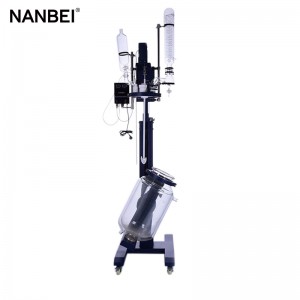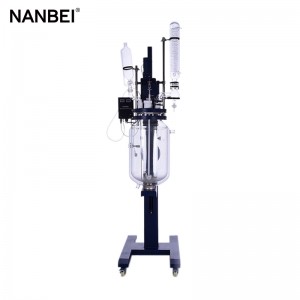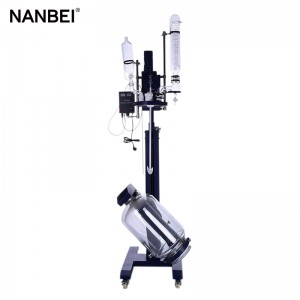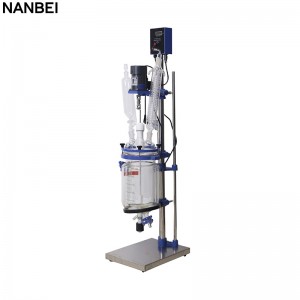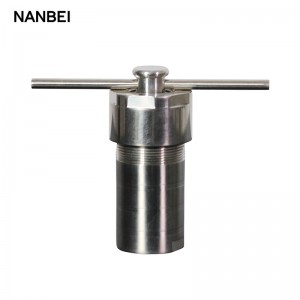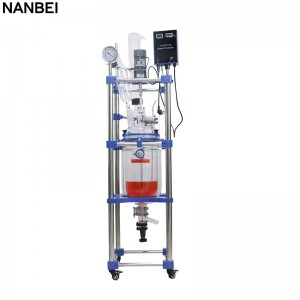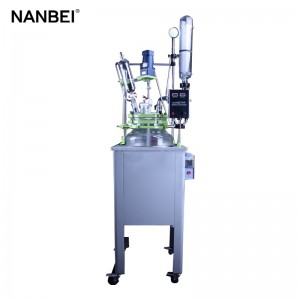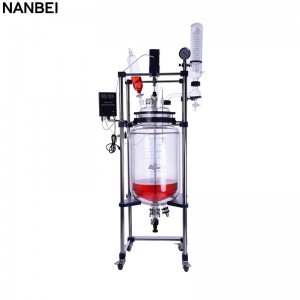Rotating Double-layer Glass Reactor
Instruction Manual for Electric Lifting and Rotating Double-layer Glass Reactor
Use
Double-layer glass reactor is a commonly used biochemical instrument, which is widely used in modern fine chemical industry, biopharmaceutical, scientific research and experiment industries. It can be used for concentration, distillation, reflux, separation and purification under constant speed, constant force and constant temperature conditions. Reaction is an ideal instrument and equipment for teaching, experiment, pilot test and production.
The lifting and rotating reactor is based on the ordinary double-layer reactor, adding the electric lifting and lowering functions of the kettle cover and the stirring system above. When the kettle cover is raised, the kettle body can be rotated 120 degrees to the left by the hand wheel, which is convenient for pouring. Compared with the traditional reactor, it greatly improves the operation efficiency and saves time and cost.
Working principle of this series of double-layer glass reactors
Through the interlayer of the double-layer reaction kettle, a constant temperature (high or low temperature) hot solution or cooling liquid is injected to heat or cool the materials in the reaction kettle at a constant temperature, and it can provide stirring. The materials are reacted in the reactor, and the evaporation and reflux of the reaction solution can be controlled. After the reaction, the materials can be discharged from the outlet at the bottom of the reactor, which is very convenient to operate. It is an ideal equipment for modern chemical sample, petrochemical, medium sample experiment, biopharmaceutical and new material synthesis.
Technical parameters of electric lifting and rotating double-layer glass reactor
|
Basic parameters |
Name |
Electric lifting and rotating double-layer glass reactor |
|||||
|
glass material |
GG-17 |
||||||
|
frame material |
Cold plate spray plastic anti-corrosion + aluminum alloy |
||||||
|
way of moving |
Universal corner wheel with brake |
||||||
|
Reaction bottle volume |
10L |
20L |
30L |
50L |
100L |
||
|
Mezzanine capacity |
6L |
8L |
10L |
13L |
18L |
||
|
Flange oil circulation port |
Low in and high out ¢35 flange |
||||||
|
Number of lids |
six |
||||||
|
discharge port off the ground |
450mm |
||||||
|
Kettle reaction temperature |
-80-250 ℃ |
||||||
|
Vacuum |
0.098Mpa |
||||||
|
stirring speed |
0-450rpm |
||||||
|
Stirring shaft diameter |
15mm |
||||||
|
lifting power |
40W1/12.5 |
||||||
|
stirring power |
90W1/3 |
120W1/3 |
250W1/3 |
||||
|
Voltage/frequency(V/Hz) |
220V/50Hz |
||||||
|
Dimensions (mm*mm*mm) |
910*730*2030(After rising2610) |
910*740*2130(After rising2710) |
980*910*2200(After rising2780) |
1000*910*2300(After rising2880) |
1100*920*2400(After rising2980) |
||
|
Package size(mm*mm*mm) |
1940*610*1030 |
1950*610*1040 |
2280*670*1090 |
2380*670*1095 |
2480*730*1195 |
||
|
Packing weight (KG) |
105 |
120 |
135 |
150 |
180 |
||
|
Function configuration |
Speed mode |
Frequency |
|||||
|
motor configuration |
Low-speed booster motor, speed ratio 3:1 |
||||||
|
Speed display mode |
Digital Display |
||||||
|
Temperature display mode |
PT100 sensor digital display |
||||||
|
PTFE component mechanical seal |
¢50 flange stirring port |
¢60 flange port |
|||||
|
Vertical high-efficiency double return condenser |
100*600mm |
100*700mm |
120*600mm |
||||
|
Reflux (distillation) unit |
Return elbow with discharge switch, 50# ball mill port |
||||||
|
Dropping device (constant pressure funnel) |
1L 40#Standard port |
2L 40#Standard port |
|||||
|
pressure relief device |
34# standard port pressure reducing valve |
||||||
|
Temperature tube |
24# standard mouth |
||||||
|
solid feed |
¢80 flange with PTFE cover |
||||||
|
Feeding method |
Inclined discharge glass discharge valve, ¢80 flange |
||||||
|
Vacuum display mode |
vacuum gauge |
||||||
|
Stirring Connection |
gimbal connection |
||||||
|
stirring rod |
Scanning + pushing stainless steel rod, outsourcing PTFE |
||||||
|
Our laboratory glass and experimental instruments are all independently developed, and can be tailored according to the actual requirements of customers. |
|||||||







